In the realm of role-playing games (RPGs), the balance between narrative depth and gameplay mechanics often presents a significant challenge. Mateusz Tomaszkiewicz, former lead quest designer for the highly acclaimed The Witcher 3, recently shed light on the intricate considerations involved in game design, particularly in developing expansive narratives within open-world environments. During an interview discussing his current project, Blood of Dawnwalker, he reflected on the skepticism encountered at CD Projekt Red (CDPR) about the potential success of embedding a complex story into a significantly more open structure.
Tomaszkiewicz emphasized that integrating expansive storytelling techniques, typically found in linear RPGs, into a dynamic open-world game was a venture fraught with uncertainty. In many ways, The Witcher 3 served as a testing ground for concepts that would later become industry standards, yet the initial hesitations regarding player reception were palpable. This highlights a critical focal point in game design: the necessity to challenge conventional approaches while remaining mindful of the player base’s expectations and preferences.
Innovative Mechanics and Player Reception
In discussing his new project, Dawnwalker, Tomaszkiewicz introduced an intriguing gameplay mechanic that incorporates “time as a resource,” which might provoke mixed reactions among players. This innovative approach reflects a broader trend in gaming where mechanics are designed to reshape player engagement and immersion. His confidence in taking risks is rooted in the successful outcomes of his previous endeavors. Yet, the introduction of unconventional mechanics invariably raises questions about player acceptance and adaptability.
The risks associated with innovating in any medium are palpable, especially when a formula has proven successful. The break from traditional structures, as seen with The Witcher 3, sets a precedent for experimentation. Tomaszkiewicz’s assertions invite a deeper exploration of how developers can learn from their experiences, considering both the triumphs and tribulations as they forge new pathways in game design.
Legacy of The Witcher 3
The significance of The Witcher 3 within the RPG genre cannot be overstated. Often lauded as one of the finest RPGs ever developed, it showcases the potential for storytelling to coexist harmoniously with expansive gameplay mechanics. As Tomaszkiewicz noted, the methods employed to mitigate risks were integral to its success. The design team’s willingness to redefine boundaries has not only influenced their future projects but has also left an indelible mark on the RPG landscape.
Yet, the challenge of maintaining narrative integrity within open-world frameworks remains an ongoing discourse among developers. Tomaszkiewicz’s reflections serve as a reminder that while innovation is critical, understanding the balance between storytelling and player agency is equally paramount.
As Tomaszkiewicz embarks on creating Blood of Dawnwalker, he brings a wealth of experience and insight that could reshape player engagement in RPGs. The road ahead may be laden with risks, but the potential for innovative storytelling and gameplay fusion provides an exhilarating prospect for both developers and players alike. The evolution of RPGs lies at the intersection of creativity, risk-taking, and an innate understanding of what players cherish most, a lesson that future game designers would do well to remember.


Leave a Reply